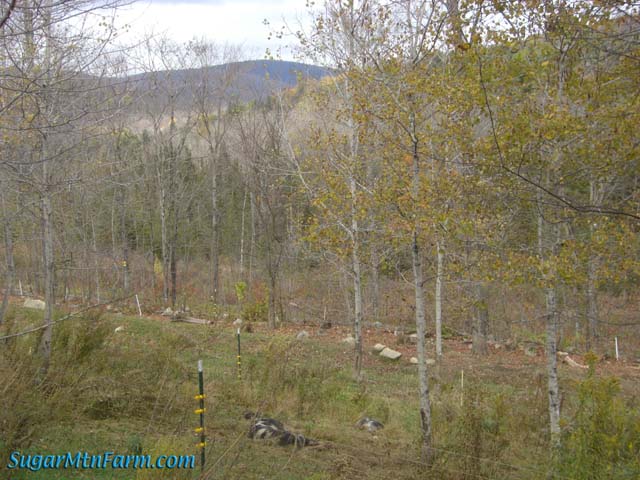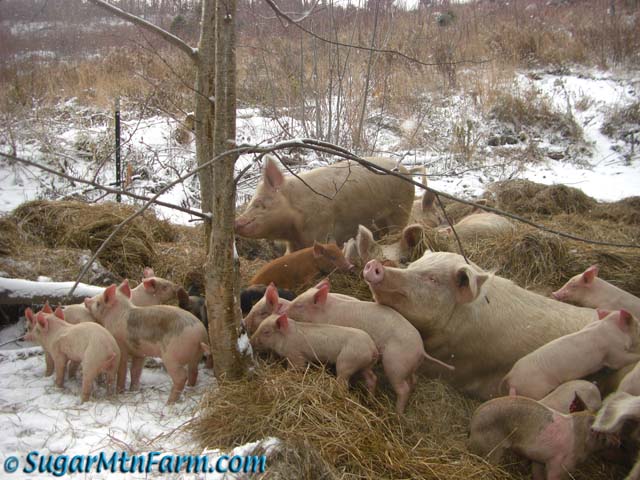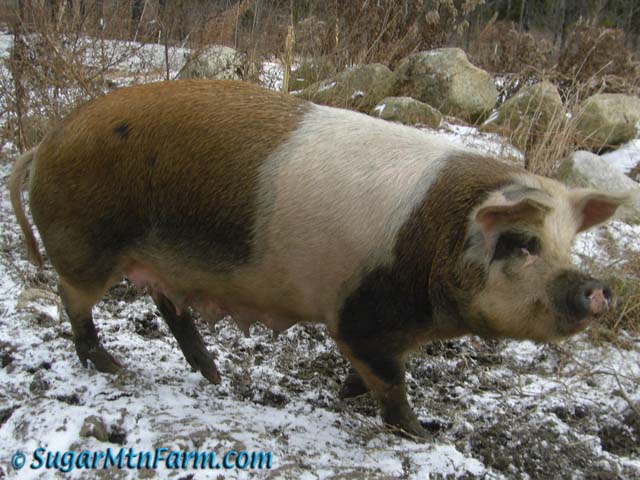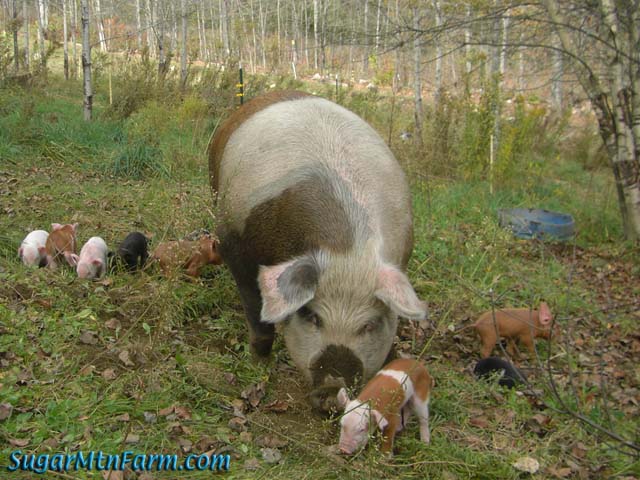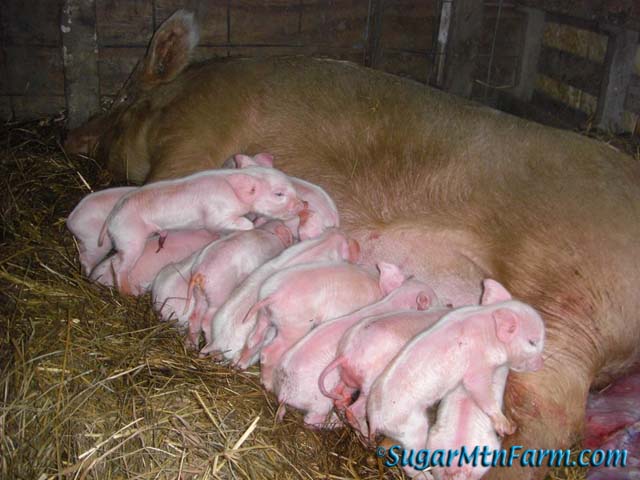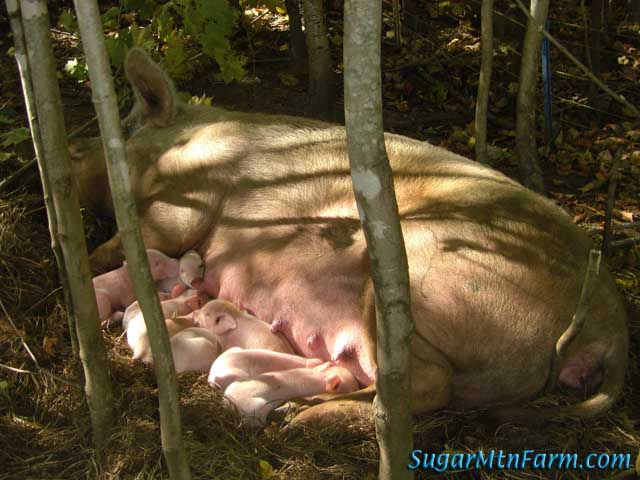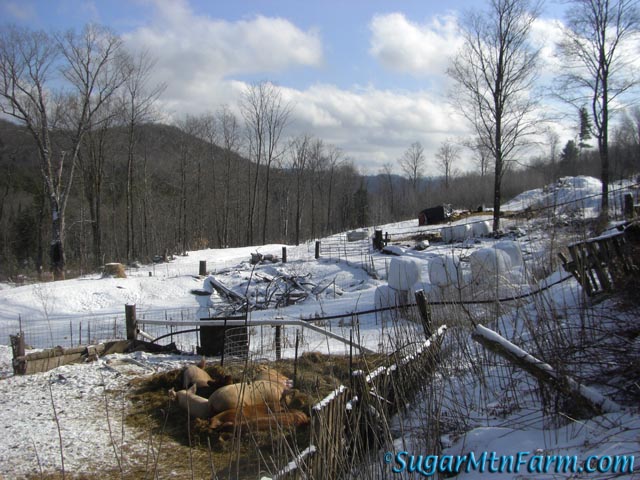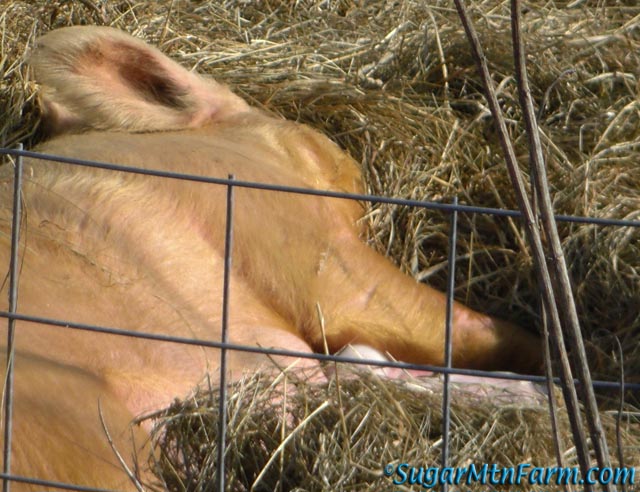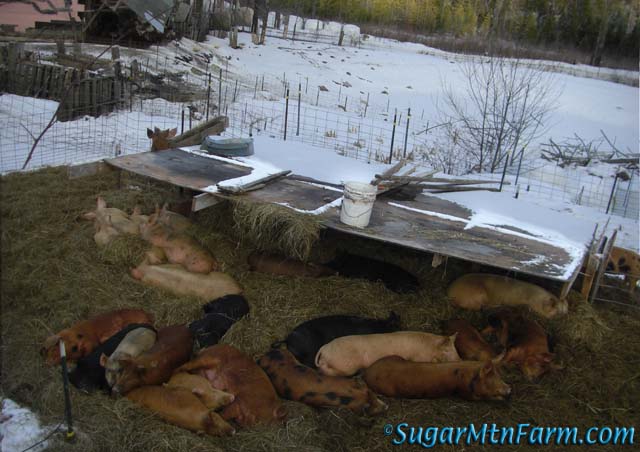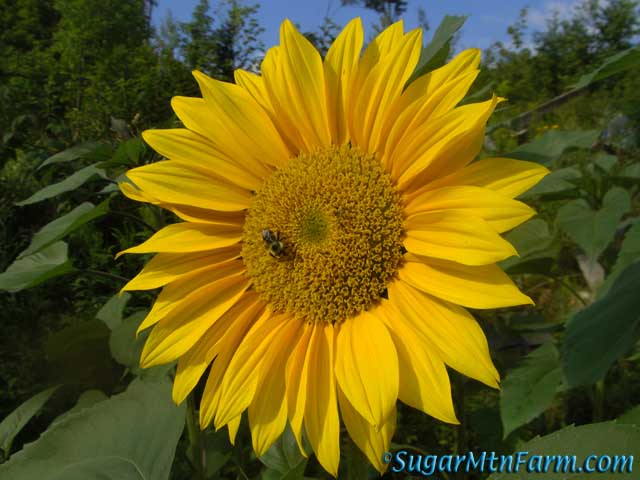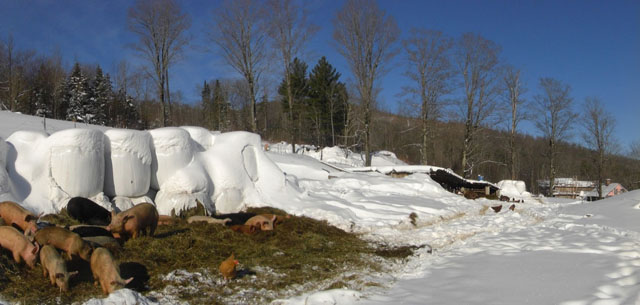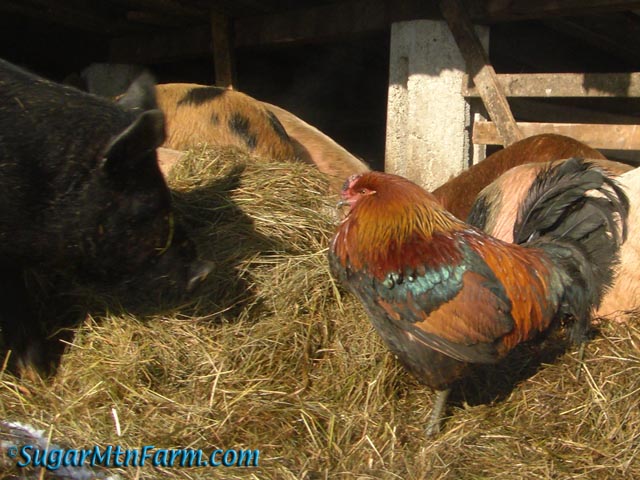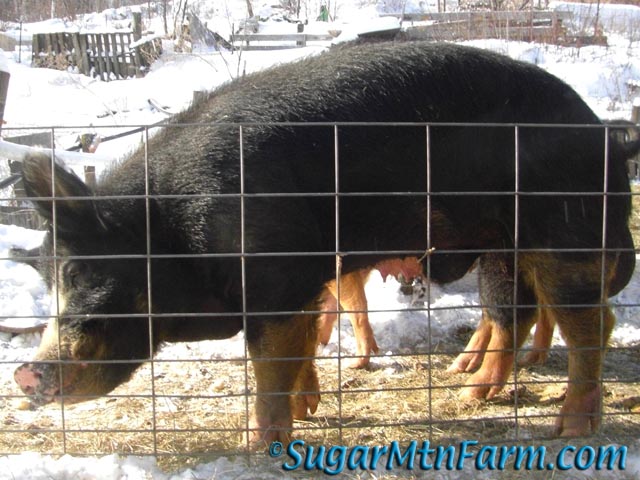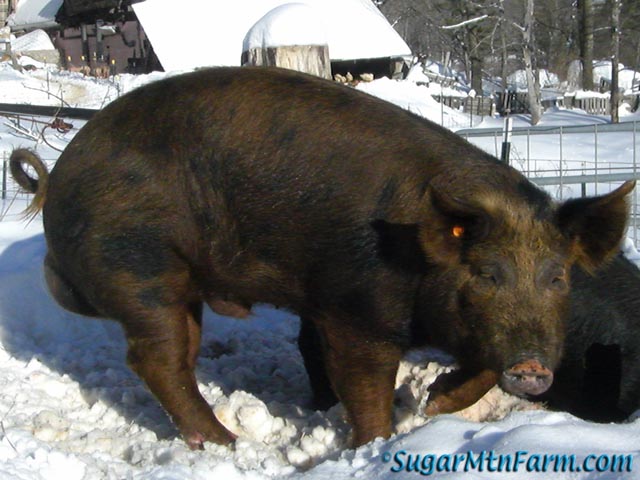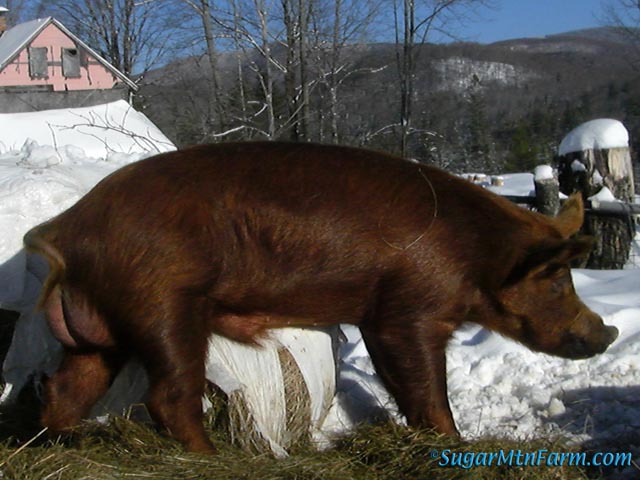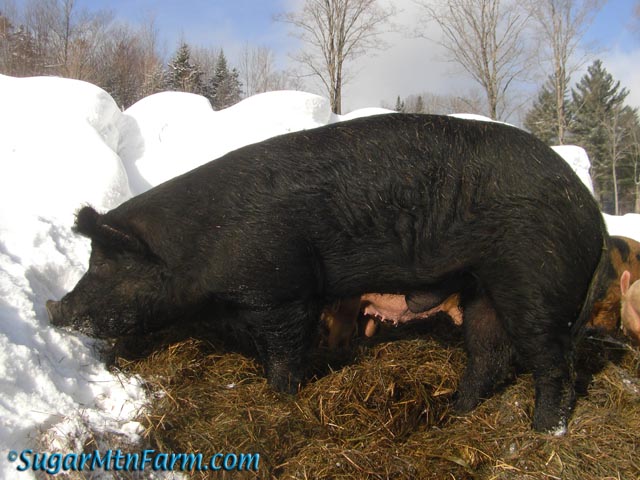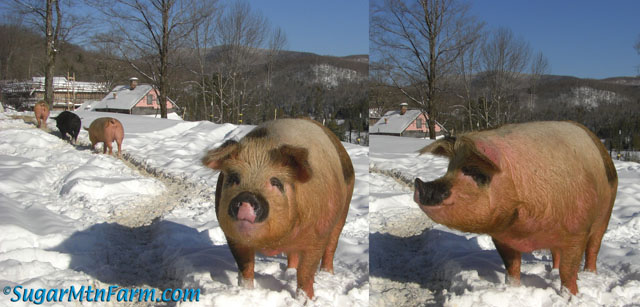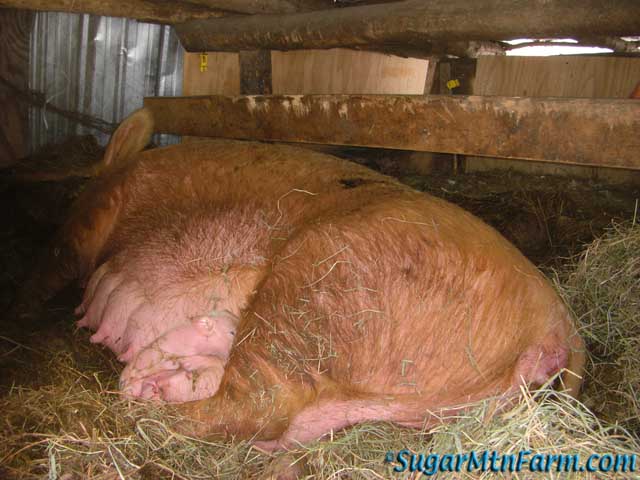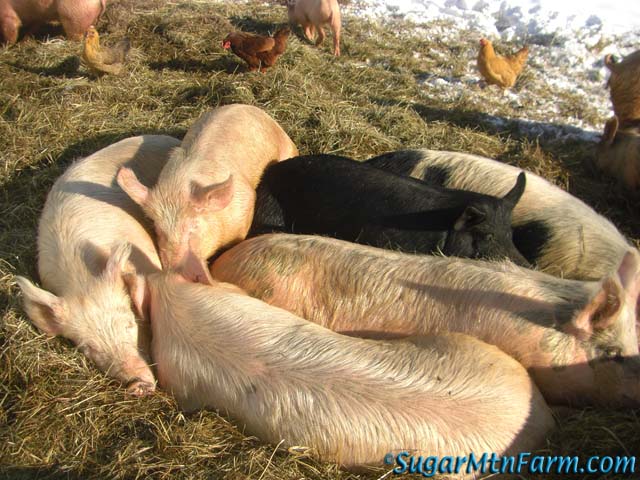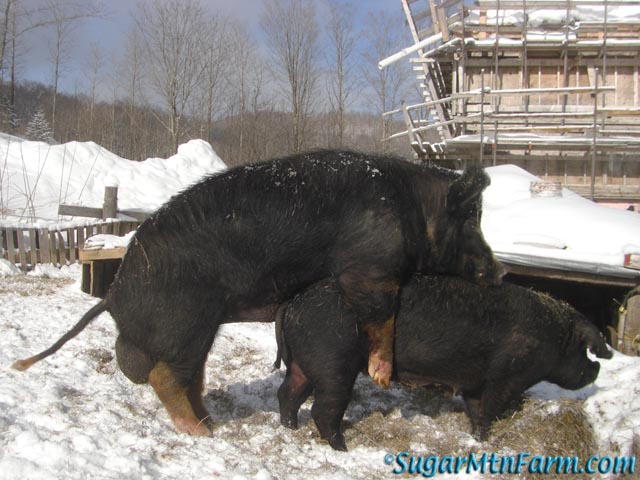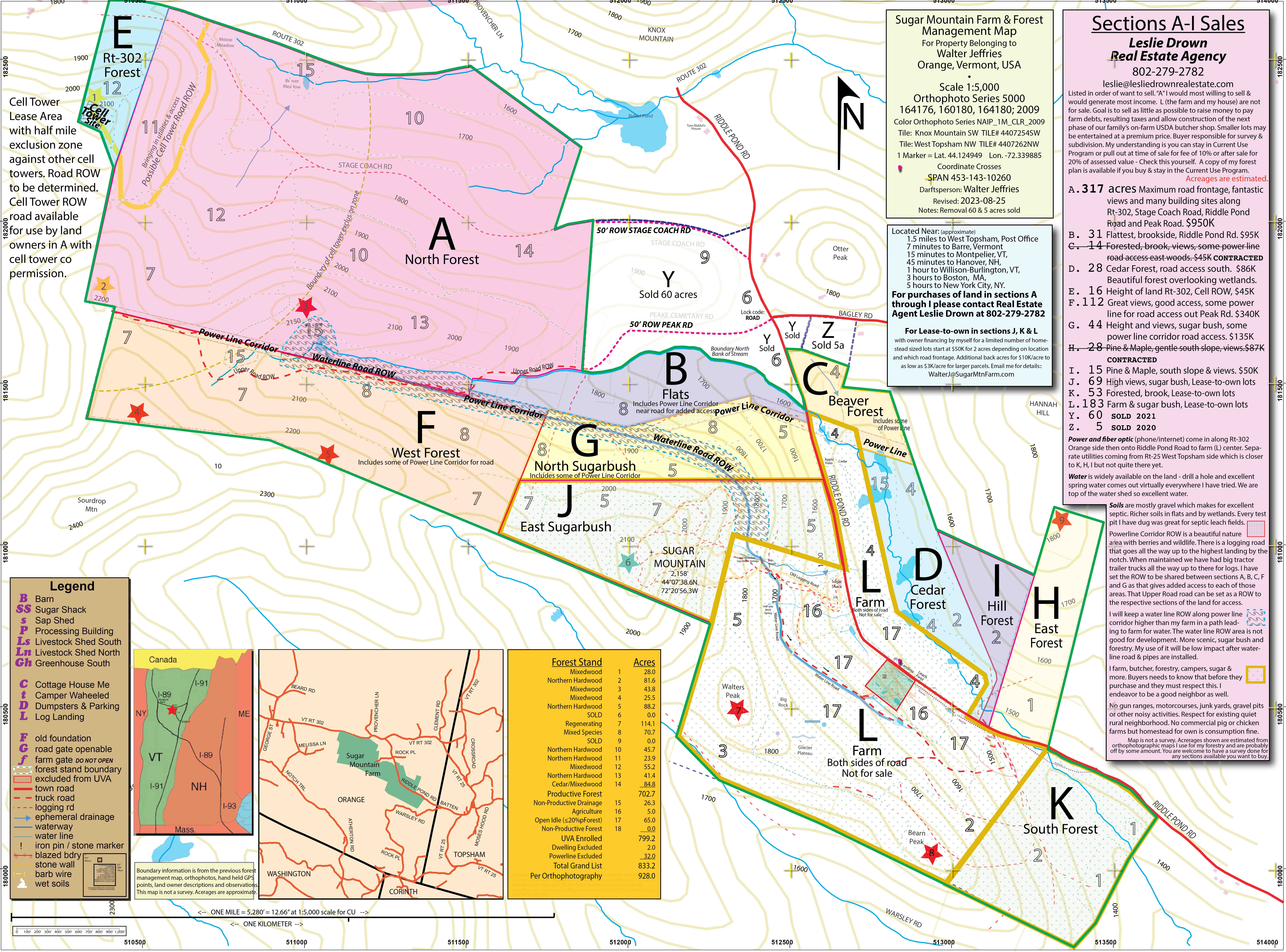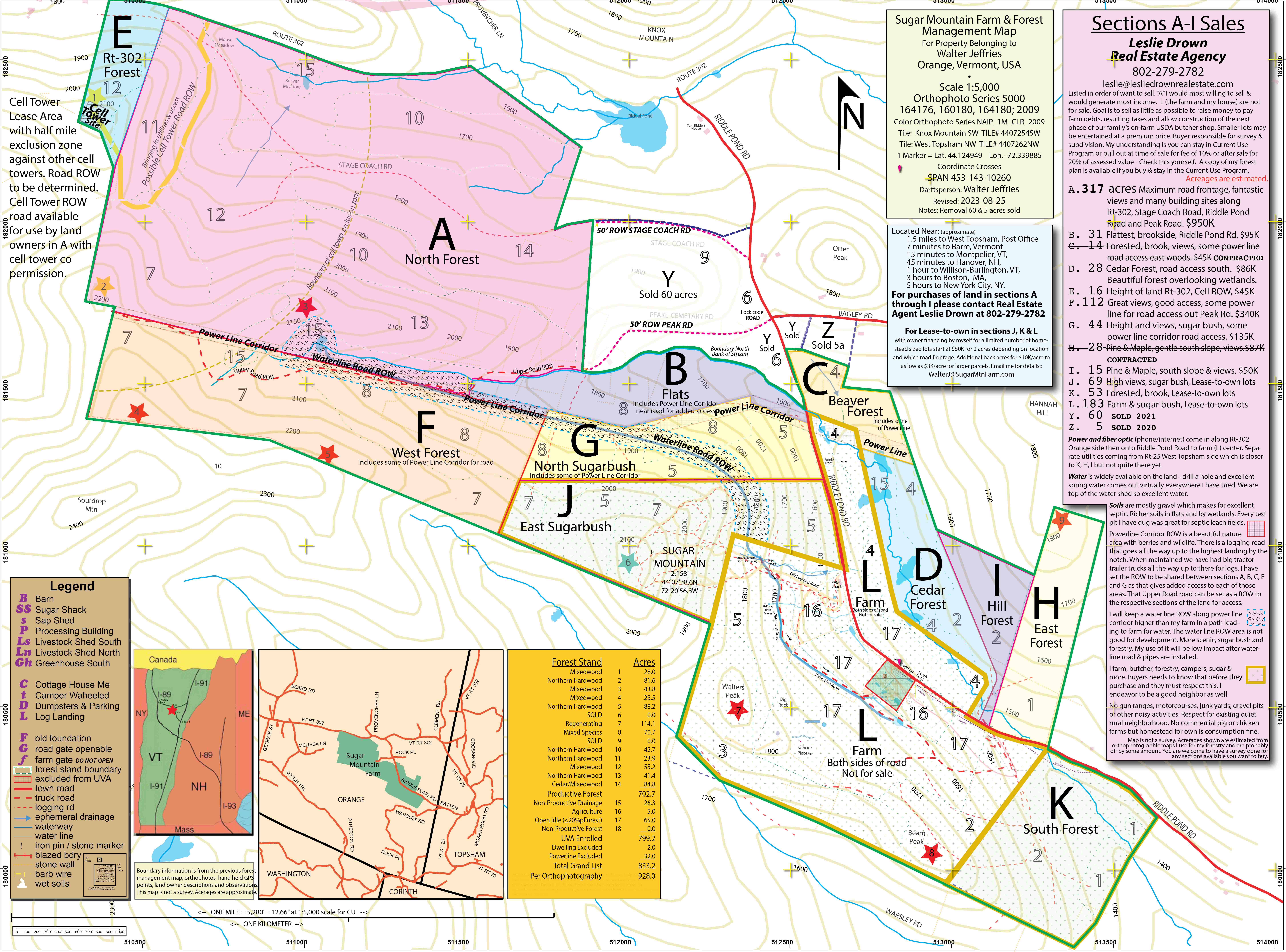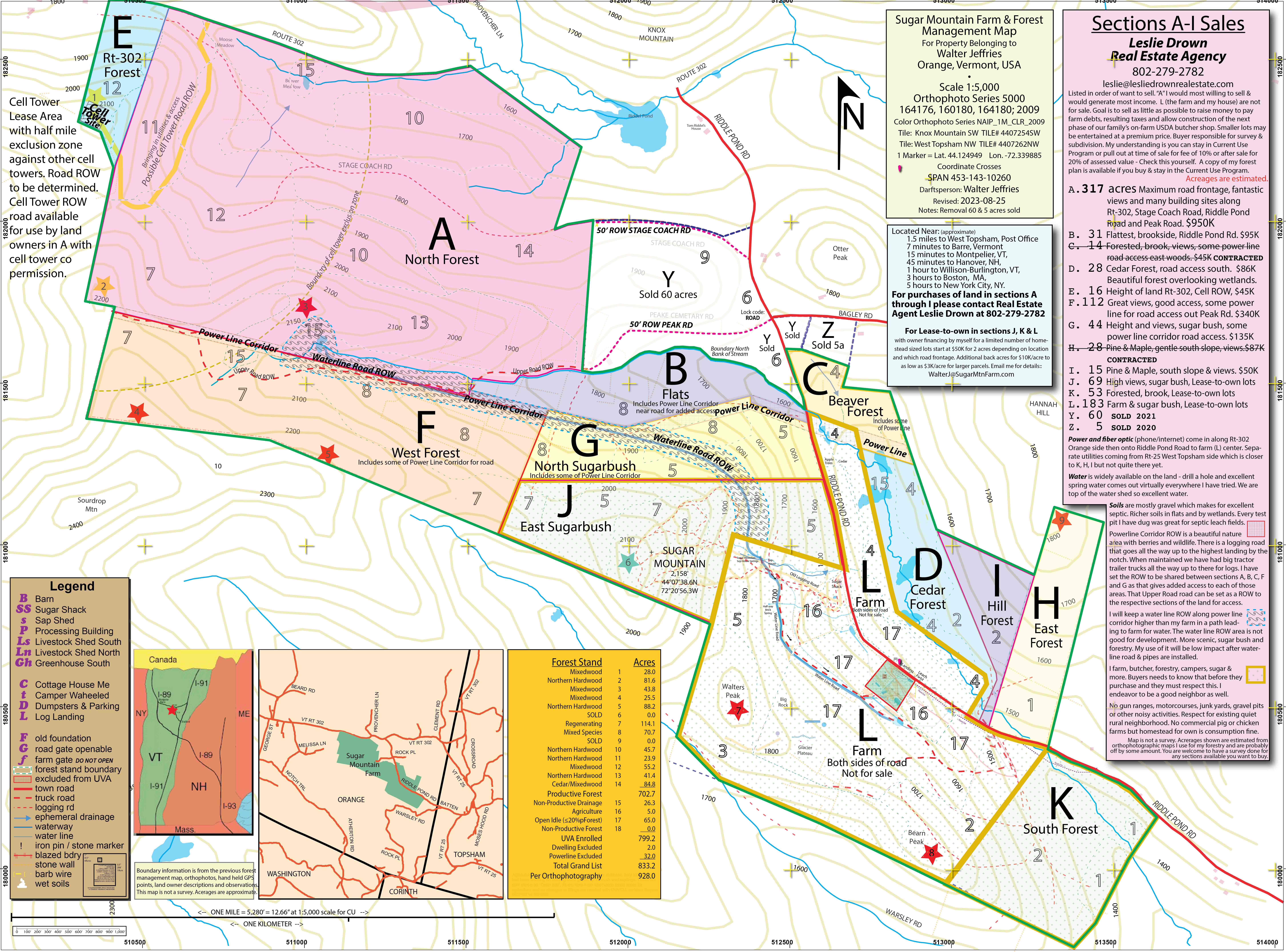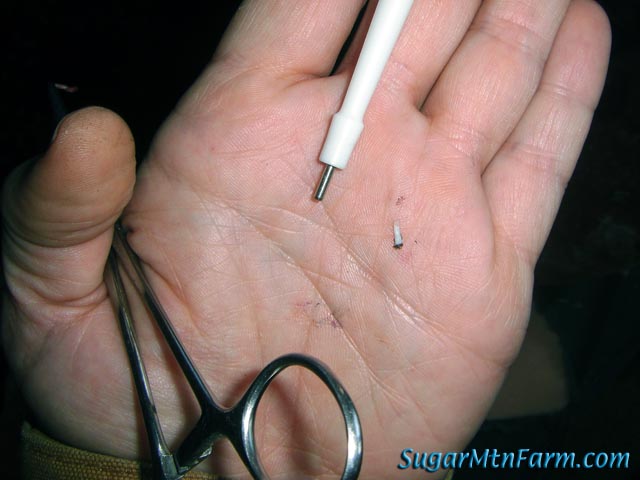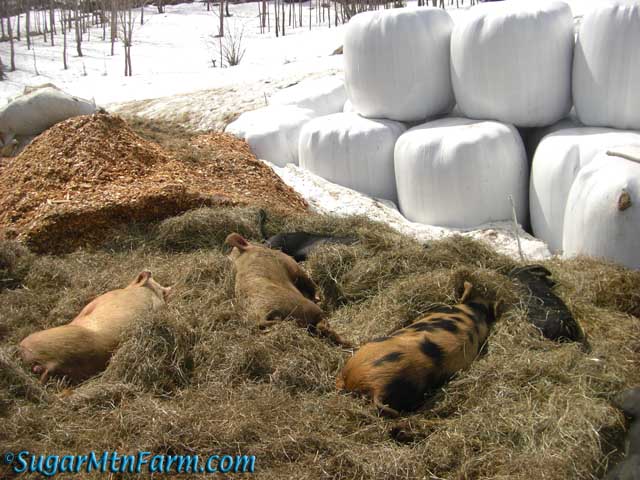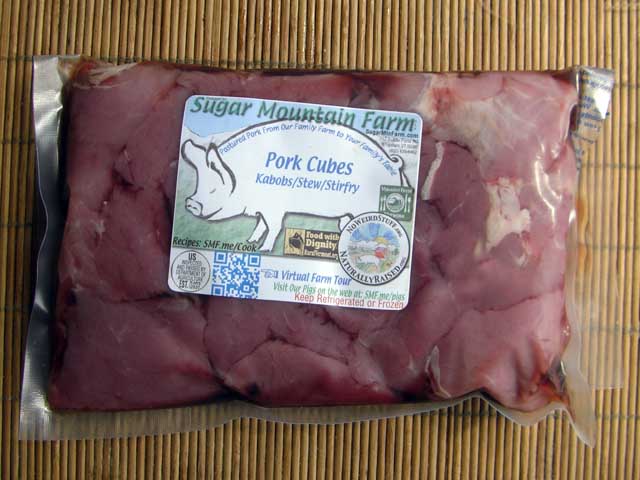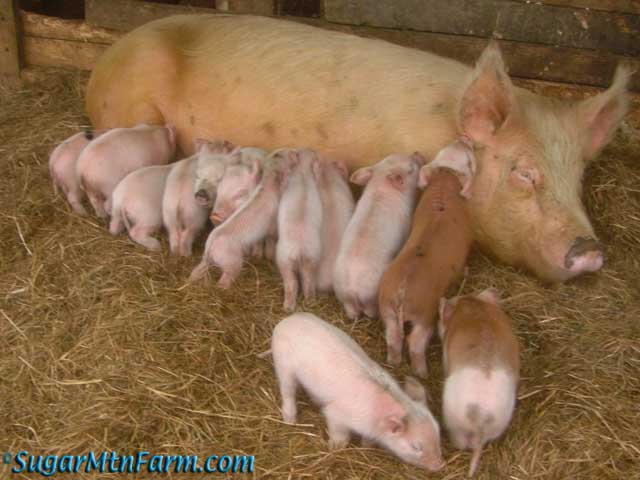![Piglets in winter pallet shed Piglets in Winter Pallet Shed]()
Someone wrote in a comment to a previous day’s posting: “I would like to raise pigs for meat for my family. I’ve been thinking about doing this for a while. Is it hard to do??? How much space do they need? Do they have to have pasture or can I just keep them in a pen? How badly do they smell??”
Note: feed, butchering and piglet prices have gone up considerably, even doubling, since I originally wrote this article.
Keeping pigs is very easy, they don’t take up much space and they don’t have to smell bad. I would suggest getting a book such as “Small Scale Pig Raising” by Dirk van Loon. That is full of information and will get you started. There are also a number of hog oriented discussion lists such as PasturedPork at Yahoo.com’s groups. But, don’t let all the information there overwhelm you. Read a bit and then dive into the muck!
At the most basic level you can imitate commercial factory farms: simply have a pen for your piglets, buy grain, fill an automatic feeder, have an automatic waterer, toss in a few bales of hay or sawdust, watched the pigs grow and then take the finished pigs to the butcher. This will work. It is the fastest and maybe the easiest way to raise a pig if you don’t have much land. The pigs don’t need to have pasture and don’t require much space (about 10′x10′ each). They will smell the worst with this method and it is the most expensive way to do it since you are providing all of their nutrition from commercially bought feed.
If you’re pen raising them in 2005 then figure:
- $65 for a piglet
- $125 for 800 lbs of grain per pig for the feed. Grain prices have been shooting up so beware that those are 2005 Vermont bag prices – adjust for your time and place.
- $35 slaughter
- $65 butchering (40¢/lb vacuum packaged for quality and better storage, based on hanging weight of 180 lbs = ~250 lb live weight)
- $40 further processing – $1.05 to $1.85 per pound for sausage making and smoking of hams, bellies, etc.
- and what ever costs you have for the pen and infrastructure like fencing and such.
- $330 or more in total
This brings the price of pork up to about $2.82 per pound for about 117 lbs of commercial cuts and smoked product plus the cost of the infrastructure. There is a lot more wonderful eating on the pig but for this exercise we’re just looking at the commercial cuts as that is a standard store comparison. Make use of the rest and you’ll push your per pound price down even further.
For that investment you’ll get hundreds of pounds of prime manure for your garden (compost it with hay, straw or wood chips), about 120 lbs of pork cuts (fresh hams, fresh bacon, pork chops, shoulders, etc), bones for soup and scraps for dogs. Be sure to ask the butcher for the bones and lard! Smoking is additional and runs about a dollar or two per pound for the smoked portions. Doing it this way won’t be cheaper than buying pork on sale at the supermarket. but it is a better quality pork, a much healthier product where you know what went into making it.
Update 2007:
The multiplier from 2005 to 2007 feed costs is 1.259 based on USDA data. This makes the 2007 cost of feed $157, Piglet were $85 this spring. Butchering has gone up to about $45 for slaughter and $0.65 per pound based on hanging weight for cut and wrap. The final cost per pig in 2007 is about $444 and the price of pork $3.80 per pound. Add your pen and labor costs to that.
- $85 for a piglet
- $157 for 800 lbs of conventional grain per pig for the feed.
- $45 slaughter – USDA inspected or on-farm are around this
- $117 butchering – vacuum packaged for quality and long lasting
- $50 further processing
- and what ever costs you have for infrastructure such as pen, fencing, troughs…
- $454 or more in total
This brings the price of pork up to about $3.88 per pound for about 117 lbs of commercial cuts and smoked product plus the cost of the infrastructure.
Update Fall 2012:
Inflation coninues, no surprise, and prices are higher now…
- $150 for a piglet (2012 fall price)
- $240 for 800 lbs of grain per pig for the feed. Grain prices are soaring with the drought and diversion to ethanol for gasoline. Conventional grain is now $15 per 50 lb bag for conventional GMO feeds and $40 for a 50 lb bag of organic feed. That sets the feed in the range of $240 to $640 per pig. Buying by the truck load will save you money but then you’ll need to figure out how to store it. Typically this means buying three to six tons at a time. Don’t buy too much at a time since grain feeds can mold which produces toxins – figure on a maximum of three months storage under proper conditions. Look at how you can supplement or replace the expensive feed with things like pasture, vegetables and fruit you grow, food excesses, etc.
- $55 slaughter – USDA inspected or on-farm are around this
- $145 butchering – vacuum packaged for quality and long lasting
- $60 further processing – $1.65 to $2.50 per pound for sausage making and smoking of hams, bellies, etc.
- and what ever costs you have for infrastructure such as pen, fencing, troughs…
- $650 or more in total
This brings the price of pork up to about $5.55 per pound for about 117 lbs of commercial cuts and smoked product plus the cost of the infrastructure. Most of that increase is due to the higher cost of grains which has been pushed up by the demand for corn based ethanol and then drought in the mid-west in recent years.
We do it a little differently here since we have plenty of land – we pasture the animals during the warm months and then during the coldest months they are in garden corrals also known as winter paddocks totally about four acres. This saves on facilities too – we have no barns but just some open sheds, simple open greenhouses and dens for the winter months.
I don’t like shoveling shit so I have the animals spread it for me. They do a most admirable job of distributing it across the pastures which improves our fields. They also till and fertilize our gardens, cut the brush and mow the fields. This saves me a lot of labor, gas and equipment. The key there is intensive rotational grazing – moving the pigs to a new spot every week or so as they use up the area they are grazing. Same idea as with sheep, goats and cattle.
Many breeds of pigs can live virtually just on pasture and then hay during the winter. This was how we did it for years before we lucked into the excess milk from the local dairy. The pigs do grow faster if they also have some other feeds besides pasture. On just pasture it takes about seven to eight months for a piglet to grow to market size (~200 to 225 lbs). On commercial feed it is only about six months. With the dairy plus pasture it’s back to about six months from birth to market.
To supplement our pasture and hay we get expired bread from the bakery, excess dairy and cheese trim. We also feed garden gleanings as well as extra pumpkins, corn and other crops we grow here on the farm. The piglets and occasionally the adult pigs also get excess eggs from our chickens during the height of production in the spring and early summer.
Pasturing the pigs is the easiest, cheapest, least smelly way to do it – in fact pigs on pasture don’t stink and are a clean animals other than a pleasant roll in their mud bath on a hot day. The pigs are a lot healthier and happier for it. On the topic of smell, a balanced diet makes a difference since most of the smell is wasted feed that are excreted when there is an excess of proteins. This isn’t so much the total protein content of the feed but rather the balance of types of proteins.
Adding carbon to the pigs diet in the form of pasture or hay as well as plenty of high carbon bedding (again we use hay) soaks up the nitrogen (often in the form of ammonia) which is the source of much of the smell. This binds the smell producing chemicals and saves them for composting into your garden. Healthy pig poops smell less.
Of course, one solution to pollution is dillution. If you had to live in a 10′x10′ box you would get pretty stinky too. If you’re raising the pigs in a pen, clean it out frequently adding fresh bedding and it will smell less.
Since I don’t like to clean pens I pasture the animals. Given the opportunity to graze on pasture in the warm months and eat hay in the winter the pigs don’t stink because they spread their own manure, keep cleaner and get plenty of fiber and carbon in their diet.
Here’s a trick: If you’re going to keep them in a pen consider using your garden or a new space you want to turn into a garden. Divide the space up into four to six sections and then rotate the pigs through the sections. Put them in each section for about one week. After they leave a section, rake in some red clover, buckwheat, turnip seeds, grass or other fast growing crops. By the time you get the pigs back onto the first area it will be a wonderful treat for the pigs and you’ll be growing some of your own feed. The pigs will appreciate rooting in the soil. Just as importantly, they need iron which they can get from dirt – otherwise you need to give them iron and vitamins for good health like the factory farms do. Doing it this way, in just one year you’ll have a very rich soil for your new garden. This technique works very well to make a garden corral for raising pigs in the winter. Note that it is important to give them plenty of hay to work into the soil to absorb the nitrogen from their pee and poop. This also adds organic matter to the soil making it fluffier – great organic gardens!
You can of course do any mix of the above techniques from small pen to a garden corral to truly pastured pigs. Do what ever fits your budget and resources. Pigs are very versatile and grow well under a wide variety of conditions making them an excellent source of meat that you can raise yourself.
Also see: Pastured Pigs
